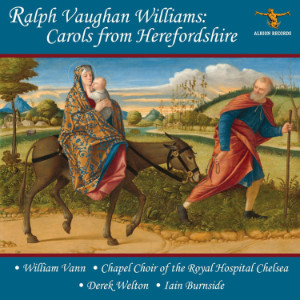
Ralph Vaughan Williams (1872-1958)
Carols from Herefordshire
Derek Wilton (bass-baritone), Iain Burnside (piano)
Chapel Choir of the Royal Hospital Chelsea/William Vann
rec. 2024, Holy Trinity, Sloane Square, London, (choir); 2011, Potton Hall, Suffolk, UK (voice and piano)
Albion Records ALBCD064 [58]
I have in front of me not only this disc with its beautiful cover of Vittore Carpaccio’s The Flight into Egypt, but a reprint of Twelve Traditional Carols from Herefordshire edited by folklorist Roy Palmer (1932-2015). It contains, the cover says, pieces collected by Mrs. E. M. Leather and R. Vaughan-Williams.
As early as in 1902, RVW came to Herefordshire to collect tunes. He visited three villages in particular, Weobley where Mrs. Leather lived, Pembridge, and Eardisley (near to my home, and a source of much local pride). It is generally thought that Mrs. Leather noted the words and RVW the tunes.
There are twelve carols in the collection. Tracks 1-12 on this neatly planned disc are RVW’s four-part (SATB) choir versions. On tracks 13-24, we hear Derek Welton’s beautifully focused and lyrical voice. Ian Burnside supplies sensitive and brilliant accompaniment.
It seems that Mrs. Leather had a phonograph. She put herself in with the hop-picking Gypsies (this still is a significant event in the farming calendar), and she collected several tunes. As an example, we have The Seven Virgins with the first line ‘Under the Leaves’. A truly modal tune with its G minor key signature, it has the typical raise submediant.
The tunes may not always be as one expects. For instance, look in the Oxford Book of Carols for No.57, and you will find two versions of Dives and Lazarus. The second one, it says maybe incorrectly, is a ‘tune noted by Mrs. Leather in Eardisley’, but it is neither of the versions here. Incidentally, this runs to fourteen verses, so director William Vann has sensibly edited it. We have two versions of The Holy Well, too, with an edited text about an apocryphal incident in the childhood of Jesus. It can be found in the Oxford Book as No.56, but neither melody relates to the two recorded here.
Returning to the Oxford Book, we find The Miraculous Harvest also called The Carnal and the Crane. It concerns the flight into Egypt. Here, all twelve verses are performed, and the choir imaginatively creates textural interest.
This is music written and arranged for good amateur singers. It is never too demanding. This choir’s vocal timbre is ideal. They are well balanced, with clear diction and a fresh uncluttered tone. Soloists often perform some stanzas to create variety, and are accompanied by vocalisation of the harmonies. There also is some very warm, unison singing at the start of each carol and in some later verses. RVW deliciously harmonised the solo vocal versions, again not beyond the ability of a good amateur.
The booklet, an absolute delight, has a detailed essay about Ella Mary Leather, a coloured photograph, and a note on each of the pieces with the text supplied. There are also several colour photos of the happy-looking choir, seven men and seven women with their conductor, William Vann.
Herefordshire’s more remote situation clearly offered more than just these twelve ancient tunes to collectors. Some people will know This is the truth sent from above collected in Weobley. Obviously, other counties and areas of England also had a tradition of folk melodies. The collectors were RVW, Gustav Holst and Cecil Sharp, among others. Perhaps these too might be collected on a similar disc in the near future.
Gary Higginson
Previous reviews: John France (October 2024) ~ Nick Barnard (October 2024)
Buying this recording via a link below generates revenue for MWI, which helps the site remain free


Contents
1 & 13 The Holy Well – version 1
2 & 14 The Holy Well – version 2
3 & 15 Christmas Now is Drawing Near at Hand
4 & 16 Joseph and Mary
5 & 17 The Angel Gabriel
6 & 18 God Rest You Merry Gentlemen
7 & 19 New Year’s Carol
8 & 20 On Christmas Day
9 & 21 Dives and Lazarus
10 & 22 The Miraculous Harvest
11 & 23 The Saviour’s Love
12 & 24 The Seven Virgins

















